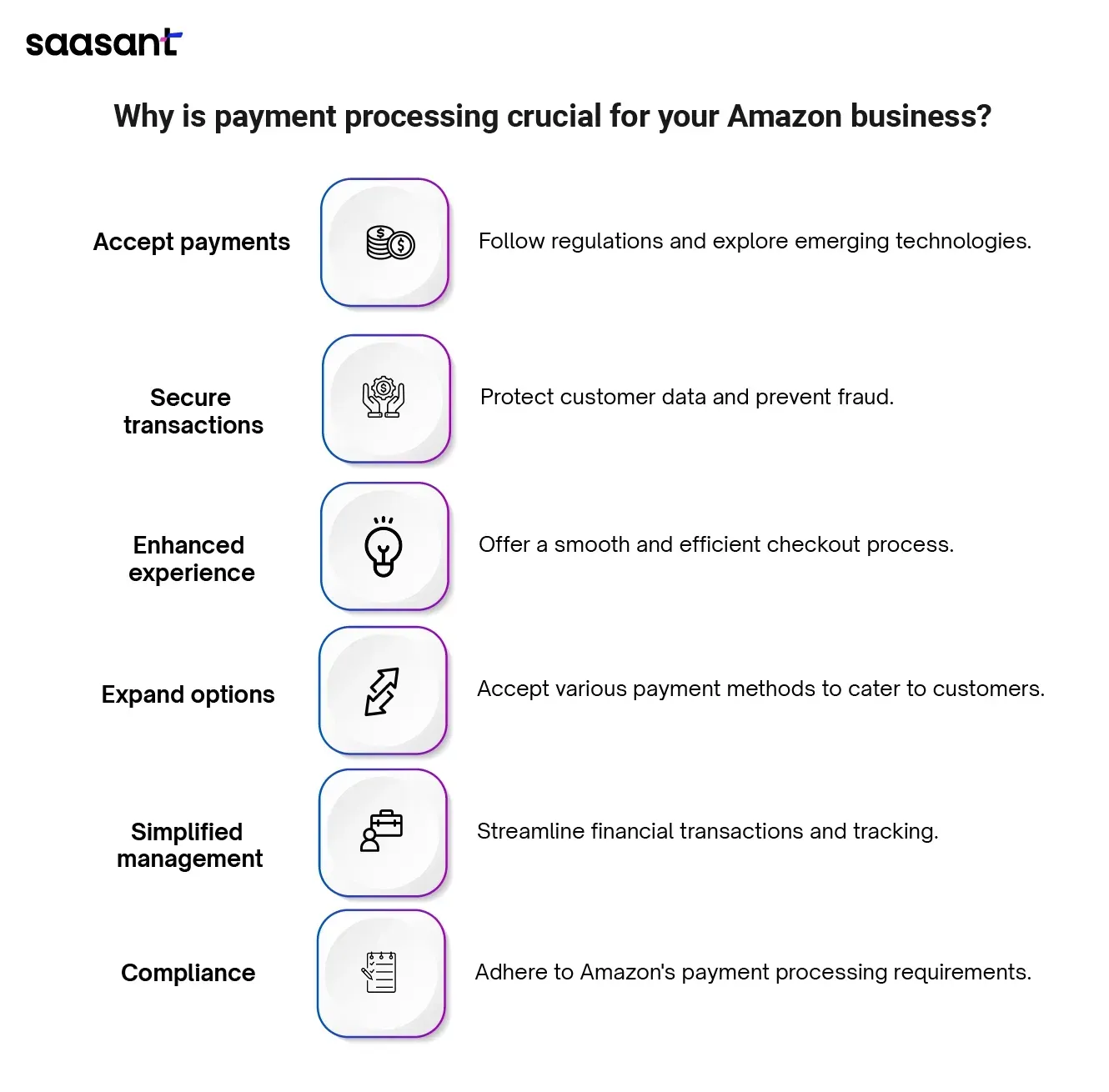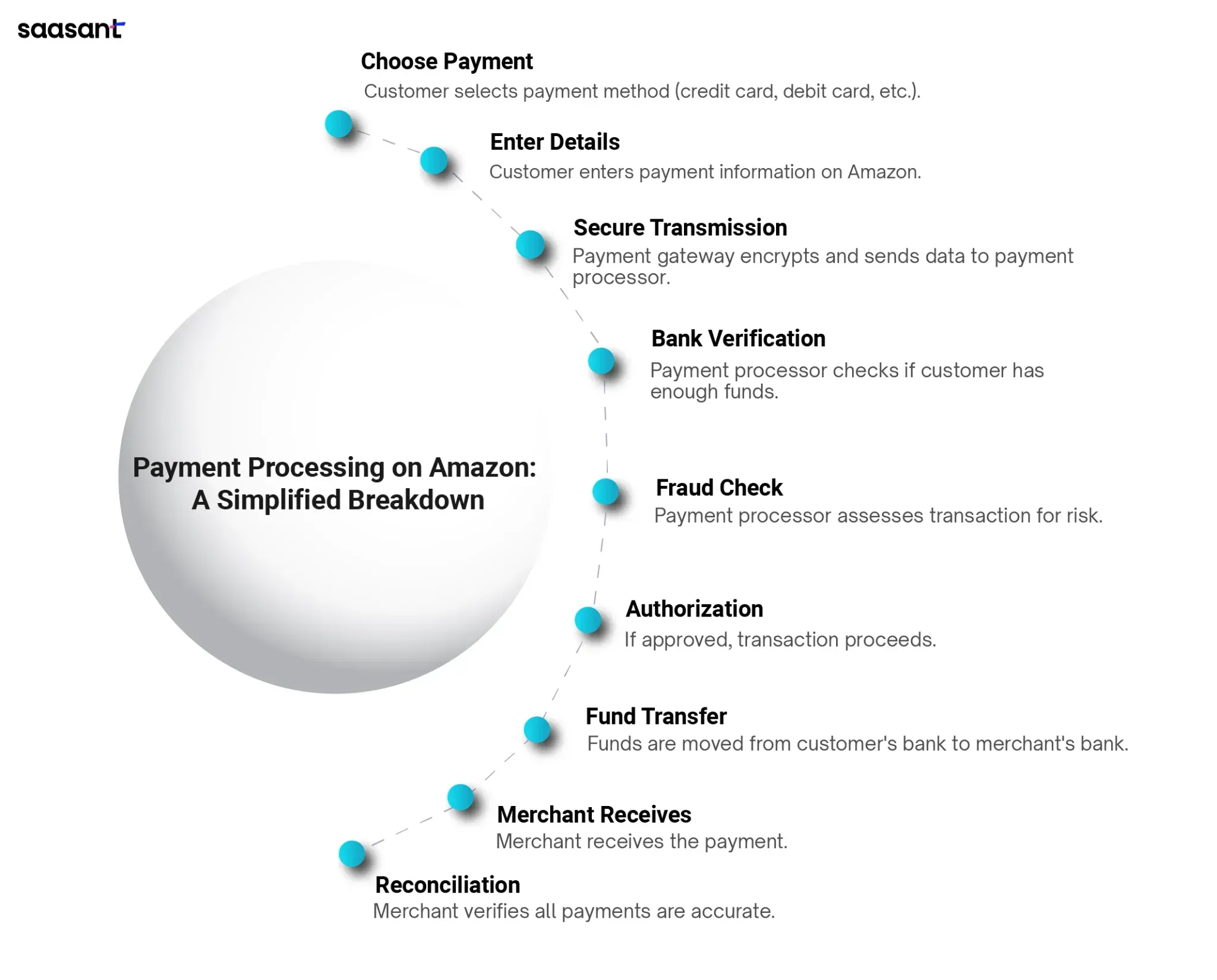A Beginner’s Guide to Payment Processing on Amazon
Introduction
The best payment processing for Amazon should be so seamless that customers barely notice it, requiring only a few clicks or a simple password entry. But for merchants, it's a whole different story. Managing financial transactions in your Amazon store can be a complex task. Also, with so many payment processors, choosing one that fits your needs doesn’t make it easier.
In this blog, we'll talk about the critical components of a good payment processor for Amazon, best practices for implementing one, and the different types of payment processors available. By the end of this blog, you'll clearly understand how to choose the suitable payment processor for your Amazon business and optimize your financial operations.
Contents
Introduction
What is Payment Processing?
Why You Need Payment Processing on Amazon
Vital Elements of Payment Processing on Amazon.com
How does payment processing for Amazon work?
Types of Payment Processing
Payment Processing Best Practices for Amazon
Conclusion
FAQ
What is Payment Processing?
Payment processing is the electronic funds transfer between a customer and a merchant. It involves online payment systems and payment gateways. A payment processor acts as a bridge between the merchant's website and the customer's bank. When a customer makes a purchase, the payment processor handles the transaction, verifies the details received from the payment gateway, and transfers funds between the bank accounts.
Why You Need Payment Processing on Amazon

Accept payments from customers: This is the primary function of payment processing. It allows you to receive payments from customers for your products or services.
Secure Transactions: Payment processing ensures that customer data is protected and transactions are secure, reducing the risk of fraud and chargebacks.
Enhanced Customer Experience: Amazon payment offers a smooth and efficient payment process that can improve customer satisfaction and encourage repeat purchases.
Expanded Payment Options: Payment processing solutions offer various payment options, including credit cards, debit cards, digital wallets, and more, catering to different customer preferences.
Simplified Financial Management: Payment processing solutions can help you manage your financial transactions, track sales, and reconcile your accounts more efficiently.
Compliance with Amazon Regulations: Adhering to Amazon's payment processing requirements is essential for maintaining a good seller account and avoiding penalties.
Vital Elements of Payment Processing on Amazon.com
Payment processing on Amazon involves several key elements working together to ensure a seamless and secure transaction. Here's a breakdown of these elements:

1. Payment Method
The payment method is the chosen option for a product or service. Standard payment methods on Amazon include:
Credit Cards: Visa, Mastercard, American Express, Discover
Debit Cards: Visa Debit, Mastercard Debit
Digital Wallets: Amazon Pay, Apple Pay, Google Pay
Gift Cards: Amazon Gift Cards, third-party gift cards
Other Options: ACH transfers, wire transfers
2. Payment Gateway
A payment gateway is a secure online platform that facilitates transactions between customers and merchants. It acts as a bridge between the Amazon website and the payment processor. The payment gateway collects payment information from the customer and transmits it securely to the payment processing system.
3. Payment Processor
A payment processor is a financial institution that handles the actual processing of payments. It verifies the payment information, authorizes the transaction, and transfers funds between the customer's bank and the merchant's account.
4. Issuing and Acquiring Bank
The customer's bank (issuing bank) is involved in the payment process. It verifies the customer's account balance and authorizes the transaction. The merchant's bank (acquiring bank) also plays a role in receiving funds from the payment processing solution.
5. Encryption
Encryption is a crucial security measure used in payment processing. It involves converting plain text data into a coded format, making it difficult for unauthorized parties to access and understand. Payment gateways and payment processors use encryption to protect sensitive customer information, such as credit card numbers.
6. Payment Reconciliation
Payment reconciliation is comparing a business's financial records with the records of its payment processor to ensure that all transactions are accounted for and accurate. This helps identify any discrepancies or errors and maintains accurate financial statements. You might need an application like PayTraQer for automatic syncing of Amazon payments.
How does payment processing for Amazon work?
Here is a step-by-step breakdown of how payment processing works for Amazon.
Payment method selection: This is the transaction initiation of payment processing, where the customer chooses how they want to pay through the payment link (e.g., credit card, debit card, digital wallet).
The payment gateway receives information: The customer enters their payment details into the payment gateway on the Amazon website.
Information encrypted and sent: The payment gateway encrypts the sensitive payment information and transmits it securely to the payment processor.
Bank verification: The payment processor sends the information to the customer's issuing bank for transaction authorization to ensure sufficient funds.
Risk and fraud assessment: The payment processor assesses the transaction for potential fraud or risk. If everything checks out, the payment processor authorizes the transaction and responds to the payment gateway as “approved” or “declined.”
Fund transfer: The payment processor requests the bank transfer funds from the customer's account to the merchant's.
The merchant receives funds: The merchant receives the funds from the payment processor.
Bank reconciliation: The merchant can reconcile their bank statements to ensure the payments have been processed correctly.
Types of Payment Processing
Amazon offers a variety of payment processing options for sellers, each with its advantages and considerations. Here are some of the most common types:
1. Amazon Payment Services:
Direct integration: Sellers can directly integrate Amazon Payments into their Amazon seller account.
Wide range of payment methods: Supports credit cards, debit cards, Amazon Pay balance, and other digital wallets.
Seller protection: Amazon payment services protect sellers against unauthorized charges and fraudulent transactions.
2. Third-Party Payment Processors:
Integration with Amazon: Sellers can integrate third-party payment processors like Stripe, PayPal, or Authorize.Net into their Amazon seller account.
Additional features: May offers recurring billing, subscription management, and advanced fraud prevention features.
Flexibility: Provides more flexibility in terms of payment options and customization.
3. Amazon Pay:
Customer-centric: Allows Amazon customers to use their existing Amazon account to pay for products and services on other websites.
Trust and convenience: Leverages Amazon's reputation and provides a familiar and seamless checkout experience for customers.
Seller benefits: Offers simplified online payment management and customer acquisition.
4. Amazon Pay Later:
Buy now, pay later: Allows customers to make purchases and pay for them over time.
Increased sales: Can attract more customers and increase sales by offering flexible payment options.
Merchant benefits: Provides a way to increase customer conversion and average order value.
5. Amazon Currency Converter:
Global reach: Enables sellers to accept payments in multiple currencies.
Simplified exchange: Automatically converts payments into the seller's preferred currency.
Reduced transaction fees: May offer competitive exchange rates and lower fees than other currency conversion services.
But the payment processing doesn’t stop there. To ensure accurate financial management, you need a reconciliation application like PayTraQer. It simplifies the integration of e-commerce payments with your accounting software, automating processes and making reconciliation a breeze. This empowers you to gain valuable insights into your financial performance, optimize your Amazon business, and maintain accurate financial reporting.
Payment Processing Best Practices for Amazon

Prioritize Customer Experience
Offer multiple payment options: Provide customers various payment options to cater to different preferences.
Ensure a seamless checkout process: Minimize friction during checkout to reduce cart abandonment.
Optimize for mobile payment: Ensure your payment system is fully optimized for mobile devices to cater to the growing number of mobile shoppers.
Focus on Security:
Choose a reputable payment processor: To protect your customers' data, select a processor with a strong security track record.
Utilize encryption: Ensure that sensitive payment information is encrypted during transmission.
Implement fraud prevention measures: Use fraud detection tools and technologies to protect your business from fraudulent transactions.
Maintain transaction limits: Set appropriate limits to reduce the risk of unauthorized charges.
Have a backup way: Develop a backup plan in case of payment processing disruptions.
Optimize for Conversion:
Minimize cart abandonment: Simplify the checkout process and offer clear calls to action to encourage customers to complete their purchases.
Provide clear payment information: Ensure payment details are easy to understand and input.
Consider Integration with Amazon Tools:
Integrate with Amazon Pay: Use Amazon Pay to provide customers a familiar and trusted payment experience.
Utilize Amazon Currency Converter: If you sell to international customers, consider using Amazon's currency converter to simplify cross-border transactions.
Manage Financial Transactions Effectively:
Use a robust payment processing solution: Choose a solution that offers features like transaction history, reporting, and reconciliation.
Reconcile your payments regularly: Compare your financial records with your payment processor's records to ensure accuracy.
Consider using a reconciliation application: Applications like PayTraQer can help you automate processes, simplify payment processing integration, and gain insights into your financial performance.
Stay Updated with Regulations and Technology:
Stay informed about payment processing regulations: Keep up-to-date with industry regulations to ensure compliance.
Embrace emerging technologies: Explore new payment processing technologies like tokenization to enhance security and improve customer experience.
Conclusion
Choosing the right payment processing solution is crucial for the success of your Amazon business. By carefully considering your business model and specific business requirements, you can select a payment processor that aligns with your goals and provides a seamless customer experience. Look for solutions that offer user-friendly features, secure transactions, and integration with Amazon's ecosystem. By optimizing your payment processing strategy, you can enhance your online presence, increase customer satisfaction, and drive your business growth in the competitive world of digital payments.
FAQ
What are the different payment methods accepted on Amazon?
Amazon accepts various payment methods, including credit cards, debit cards, digital wallets (like Amazon Pay, Apple Pay, Google Pay), gift cards, and ACH transfers.
How does Amazon handle payment security?
Amazon employs robust security measures to protect customer payment information. These measures include encryption, tokenization, and advanced fraud detection capabilities.
How do I reconcile my Amazon payments with my accounting software?
Many payment processors offer integration with popular accounting software, making it easier to reconcile your Amazon payments. You can also use applications like PayTraQer to simplify this process.
How do I manage refunds and chargebacks on Amazon?
Amazon has specific policies and procedures for handling refunds and chargebacks. It's important to familiarize yourself with these guidelines to ensure compliance and protect your business.
What are the steps in payment processing?
Payment processing typically involves several steps: authorization, where the customer's funds are verified; settlement, where the funds are transferred from the customer's bank to the merchant's bank; and reconciliation, where the transaction is confirmed and recorded.